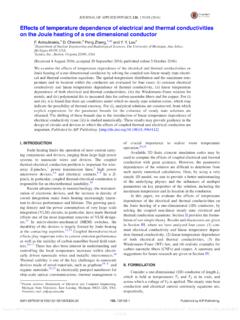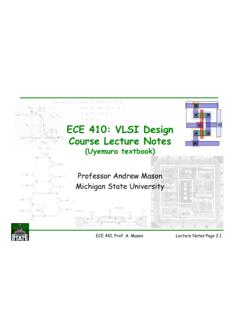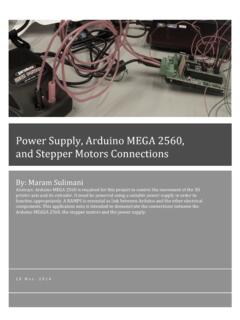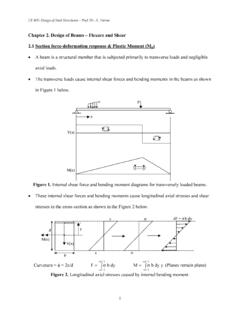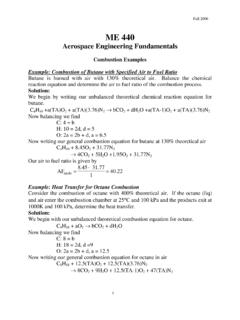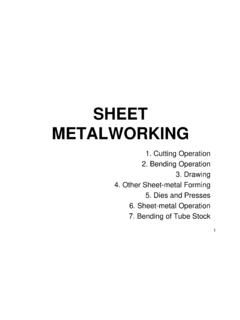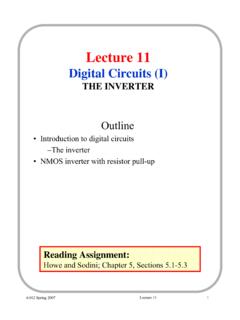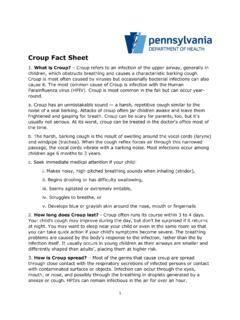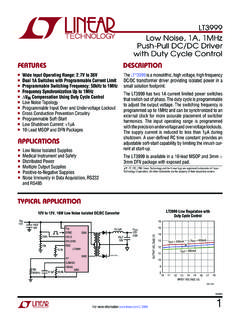Transcription of CMOS Inverter: DC Analysis - Michigan State University
1 ECE 410, Prof. A. MasonLecture Notes Inverter: DC Analysis Analyze DC Characteristics of CMOS Gates by studying an Inverter DC Analysis DC value of a signal in static conditions DC Analysis of CMOS Inverter Vin, input voltage Vout, output voltage single power supply, VDD Ground reference find Vout = f(Vin) Voltage Transfer Characteristic (VTC) plot of Vout as a function of Vin vary Vin from 0 to VDD find Vout at each value of VinECE 410, Prof. A. MasonLecture Notes Voltage Transfer Characteristics Output High Voltage, VOH maximum output voltage occurs when input is low (Vin = 0V) pMOS is ON, nMOS is OFF pMOS pulls Vout to VDD VOH= VDD Output Low Voltage, VOL minimum output voltage occurs when input is high (Vin = VDD) pMOS is OFF, nMOS is ON nMOS pulls Vout to Ground VOL= 0 V Logic Swing Max swing of output signal VL= VOH-VOL VL= VDDECE 410, Prof.
2 A. MasonLecture Notes Voltage Transfer Characteristics Gate Voltage, f(Vin) VGSn=Vin, VSGp=VDD-Vin Transition Region (between VOHand VOL) Vinlow Vin< Vtn Mnin Cutoff, OFF Mp in Triode, Vout pulled to VDD Vin> Vtn< ~Vout Mn in Saturation, strong current Mp in Triode, VSG& current reducing Vout decreases via current through Mn Vin = Vout (mid point) VDD Mn and Mp both in Saturation maximum current at Vin = Vout Vinhigh Vin > ~Vout, Vin < VDD - |Vtp| Mn in Triode, Mp in Saturation Vin > VDD - |Vtp| Mnin Triode, Mp in Cutoff+VGSn-+VSGp-Vin < VILinput logic LOWVin > VIHinput logic HIGH Drain Voltage, f(Vout) VDSn=Vout, VSDp=VDD-VoutECE 410, Prof.
3 A. MasonLecture Notes Margin Input Low Voltage, VIL Vin such that Vin < VIL= logic 0 point a on the plot where slope, Input High Voltage, VIH Vin such that Vin > VIH= logic 1 point b on the plot where slope =-1 Voltage noise Margins measure of how stable inputs are with respect to signal interference VNMH= VOH-VIH= VDD - VIH VNML= VIL-VOL= VIL desire large VNMHand VNMLfor best noise immunity1 = VoutVinECE 410, Prof. A. MasonLecture Notes Threshold Switching threshold = point on VTC where Vout = Vin also called midpoint voltage, VM here, Vin = Vout = VM Calculating VM at VM, both nMOS and pMOS in Saturation in an inverter, IDn= IDp, always!
4 Solve equation for VM express in terms of VM solve for VMDptpSGpptnGSnntnGSnOXnDnIVVVVVVLWCI= = = =222)(2)(2)(2 22)(2)(2tpMDDptnMnVVVVV = tpMDDtnMpnVVVVV = )( pnpntntpMVVVDDV ++ =1 ECE 410, Prof. A. MasonLecture Notes of Transistor Size on VTC Recall If nMOS and pMOS are same size (W/L)n = (W/L)p Coxn= Coxp(always) If Effect on switching threshold if n pand Vtn = |Vtp|, VM= VDD/2, exactly in the middle Effect on noise margin if n p, VIHand VILboth close to VMand noise margin is goodLWknn'= ppnnpnLWkLWk ='' pnpntntpMVVVDDV ++ =132orLWCLWC pnpoxppnoxnnpn = = 1,= =pnnppnthenLWLW since L normally min.
5 Size for all tx,can get betas equal by making Wp larger than WnECE 410, Prof. A. MasonLecture Notes Given k n = 140uA/V2, Vtn = , VDD = 3V k p = 60uA/V2, Vtp = Find a) tx size ratio so that VM= b) VMif tx are same sizetransition pushed loweras beta ratio increasesECE 410, Prof. A. MasonLecture Notes Inverter: Transient Analysis Analyze Transient Characteristics of CMOS Gates by studying an Inverter Transient Analysis signal value as a function of time Transient Analysis of CMOS Inverter Vin(t), input voltage, function of time Vout(t), output voltage, function of time VDD and Ground, DC (not function of time) find Vout(t) = f(Vin(t)) Transient Parameters output signal rise and fall time propagation delayECE 410, Prof.
6 A. MasonLecture Notes Response Response to step change in input delays in output due to parasitic R & C Inverter RC Model Resistances Rn= 1/[ n(VDD-Vtn)] Rp= 1/[ n(VDD-|Vtp|)] Output Cap. (only output is important) CDn(nMOS drain capacitance) CDn= Cox WnL + CjADnbot+ CjswPDnsw CDp(pMOS drain capacitance) CDp= Cox WpL + CjADpbot+ CjswPDpsw Load capacitance, due to gates attached at the output CL= 3 Cin = 3 (CGn+ CGp), 3 is a typical load Total Output Capacitance Cout= CDn+ CDp+ CL+Vout-CLterm fan-out describes# gates attached at outputECE 410, Prof.
7 A. MasonLecture Notes Time Fall Time, tf time for output to fallfrom 1 to 0 derivation: initial condition, Vout(0) = VDD solution definition tfis time to fall from90% value [V1,tx]to 10% value [V0,ty] tf= nnoutoutoutRVtVCi= =ntDDeVtVout =)( n= RnCouttime constant =VoutVtDDnln = ECE 410, Prof. A. MasonLecture Notes Time Rise Time, tr time for output to rise from 0 to 1 derivation: initial condition, Vout(0) = 0V solution definition tfis time to rise from10% value [V0,tu]to 90% value [V1,tv] tr= p Maximum Signal Frequency fmax= 1/(tr+ tf) faster than this and the output can t settle p= RpCouttime constantpoutDDoutoutRVVtVCi = = = ptDDeVtVout 1)(ECE 410, Prof.
8 A. MasonLecture Notes Delay Propagation Delay, tp measures speed of output reaction to input change tp= (tpf+ tpr) Fall propagation delay, tpf time for output to fall by 50% reference to input change by 50% Rise propagation delay, tpr time for output to rise by 50% reference to input change by 50% Ideal expression (if input is step change) tpf= ln(2) n tpr= ln(2) p Total Propagation Delay tp= ( n + p)Propagation delay measurement:- from time input reaches 50% value- to time output reaches 50% valueAdd rise and fall propagation delays for total valueECE 410, Prof.
9 A. MasonLecture Notes Speed -Resistance Rise & Fall Time tf= n, tr= p, Propagation Delay tp= ( n + p) In General delay n + p n + p= Cout (Rn+Rp) Define delay in terms of design parameters Rn+Rp= (VDD-Vt)( n+ p) Rn+Rp= n + p if Vt = Vtn = |Vtp| n= RnCout p= RpCoutRn = 1/[ n(VDD-Vtn)]Rp = 1/[ p(VDD-|Vtp|)]Cout = CDn+ CDp+ CL = Cox (W/L) n p(VDD-Vt)2 n p(VDD-Vt)Rn+Rp = 2 = 2 L (VDD-Vt)Rn+Rp = L ( n+ p) Cox W(VDD-Vt)( n p) Cox W (VDD-Vt)and L=Ln=LpBeta Matchedif n= p= ,Width Matchedif Wn=Wp=W,To decrease R s, L, W, VDD, ( p, Cox )ECE 410, Prof.
10 A. MasonLecture Notes Speed -Capacitance From Resistance we have L, W, VDD, ( p, Cox ) but VDD increases power W increases Cout Cout Cout = Cox L (Wn+Wp) + Cj2L (Wn+Wp) + 3 Cox L (Wn+Wp) assuming junction area ~W 2L neglecting sidewall capacitance Cout L (Wn+Wp) [3 Cox +2 Cj] Cout L (Wn+Wp) Delay Cout(Rn+Rp) L W LCout = CDn+ CDp+ CLCL= 3 (CGn+ CGp) = 3 Cox (WnL+WpL)CDp= Cox WpL + CjADpbot+ CjswPDpswCDn= Cox WnL + CjADnbot+ CjswPDnswestimateif L=Ln=LpW~2 LLTo decrease Cout, L, W, ( Cj, Cox )W VDD= L2 VDDD ecreasing L (reducing feature size)is best way to improve speed!


